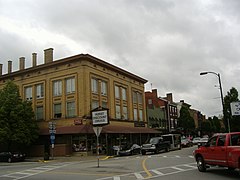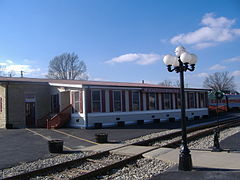
Nelson County is a county located in the U.S. state of Kentucky. As of the 2020 census, the population was 48,065. Its county seat is Bardstown. Nelson County comprises the Bardstown, KY Micropolitan Statistical Area, which is also included in the Louisville/Jefferson County-Elizabethtown-Madison, KY-IN Combined Statistical Area.
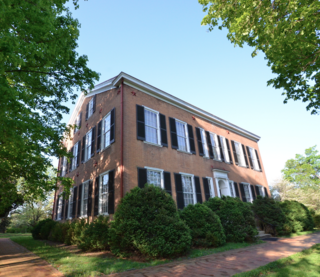
Bardstown is a home rule-class city in Nelson County, Kentucky, United States. The population was 13,567 in the 2020 census. It is the county seat of Nelson County.
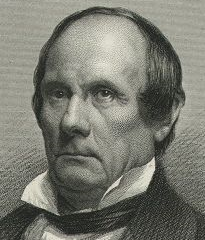
James Guthrie was an American lawyer, plantation owner, railroad president and Democratic Party politician in Kentucky. He served as the 21st United States Secretary of the Treasury under Presidents Franklin Pierce and James Buchanan, and then became president of the Louisville and Nashville Railroad. After serving, part-time, in both houses of the Kentucky legislature as well as Louisville's City Council before the American Civil War, Guthrie became one of Kentucky's United States Senators in 1865. Guthrie strongly opposed proposals for Kentucky to secede from the United States and attended the Peace Conference of 1861. Although he sided with the Union during the Civil War, he declined President Abraham Lincoln's offer to become the Secretary of War. As one of Kentucky's Senators after the war, Guthrie supported President Andrew Johnson and opposed Congressional Reconstruction.
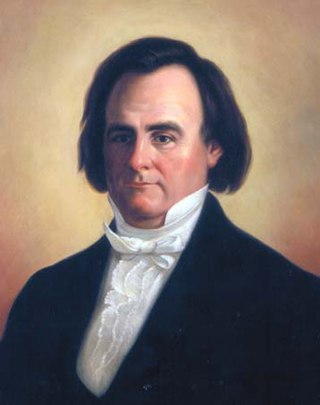
Charles Anderson Wickliffe was a U.S. Representative from Kentucky. He also served as Speaker of the Kentucky House of Representatives, the 14th Governor of Kentucky, and was appointed Postmaster General by President John Tyler. Though he consistently identified with the Whig Party, he was politically independent, and often had differences of opinion with Whig founder and fellow Kentuckian Henry Clay.
The American Whiskey Trail is the name of a promotional program supported by the Distilled Spirits Council of the United States that promotes the distilled beverage industry in the U.S. The Trail was first promoted to the public on September 28, 2004.

My Old Kentucky Home State Park is a state park located in Bardstown, Kentucky, United States. The park's centerpiece is Federal Hill, a former plantation home owned by United States Senator John Rowan in 1795. During the Rowan family's occupation, the mansion became a meeting place for local politicians and hosted several visiting dignitaries.

John Rowan was a 19th-century politician and jurist from the U.S. state of Kentucky. Rowan's family moved from Pennsylvania to the Kentucky frontier when he was young. From there, they moved to Bardstown, Kentucky, where Rowan studied law with former Kentucky Attorney General George Nicholas. He was a representative to the state constitutional convention of 1799, but his promising political career was almost derailed when he killed a man in a duel stemming from a drunken dispute during a game of cards. Although public sentiment was against him, a judge found insufficient evidence against him to convict him of murder. In 1804, Governor Christopher Greenup appointed Rowan Secretary of State, and he went on to serve in the Kentucky House of Representatives and the U.S. House of Representatives.

U.S. Route 31E (US 31E) is the easternmost of two parallel routes for U.S. Highway 31 from Nashville, Tennessee, to Louisville, Kentucky.
The Louisville and Nashville Turnpike was a toll road that ran from Louisville, Kentucky to Nashville, Tennessee during the 19th century. From Louisville, one route now designated US 31W ran through Elizabethtown, Munfordville, Glasgow Junction, Bowling Green, and Franklin before crossing into Tennessee. In Tennessee, the route would continue through Portland, Cross Plains, Millersville and Goodlettsville before going into Nashville. The other route ran through Bardstown, Buffalo, Glasgow, and Scottsville and is currently named US 31E. The name survives in abbreviated form along routes including Kentucky State Routes 335 and 470. US 31W is usually named for the Dixie Highway which succeeded the Turnpike.

The Kentucky Bourbon Trail is the name of a program sponsored by the Kentucky Distillers' Association (KDA) to promote the Bourbon whiskey industry in Kentucky. The KDA has registered the phrase "Kentucky Bourbon Trail" as a protected trademark.

The Old Talbott Tavern, also known as the Old Stone Tavern, a historic tavern built in 1779, is located in the Bardstown Historic District of Bardstown, Kentucky, across from the historic Nelson County Courthouse. It was placed on the National Register of Historic Places on October 30, 1973.

The Cobblestone Path is a historic pathway along the east side of the Bardstown Historic District of Bardstown, Kentucky, passing by eight acres of land. Once longer, due to various construction it now remains between Flaget Avenue and Broadway, directly across from the Bardstown Civil War Museum. Because it was always considered part of the city's street system, the Cobblestone Path is owned by the City of Bardstown, even though it now serves only pedestrian traffic.

The historic Nelson County Jail in the Bardstown Historic District in Bardstown, Kentucky is a property on the National Register of Historic Places. It is next door to the Old Talbott Tavern.The property served as Nelson County, Kentucky's jail from 1797 to 1987. The old jail was originally built in 1819.

The Old Stone Tavern, near Frankfort, Kentucky, is a historic stone building that once served as an inn and tavern on a stagecoach line, and later served as a toll house. It was listed on the National Register of Historic Places in 1983.

Joseph & Joseph is an architectural firm founded in 1908 in Louisville, Kentucky. The main services include architectural, engineering and design projects.
Luckett & Farley is an architecture, engineering, and interior design firm based in Louisville, Kentucky. It was founded in 1853, making it the oldest continually operating architecture firm in the United States that is not a wholly owned subsidiary. The firm began under the name Rogers, Whitestone & Co., Architects, changing its name to Henry Whitestone in 1857, to D.X. Murphy & Brother in 1890, and to Luckett & Farley in 1962. The company is 100% employee-owned as of January 1, 2012 and concentrates on automotive, industrial, federal government, higher education, health and wellness, and corporate/commercial markets. There are more LEED professionals at Luckett & Farley than any other company in Kentucky with 50, as of December 2012.
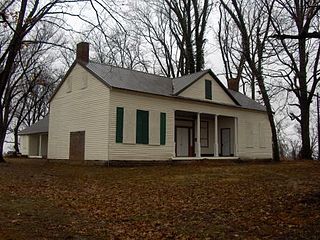
The Sherman Tavern, near Sherman, Kentucky, was built in about 1840. It was listed on the National Register of Historic Places in 1979.
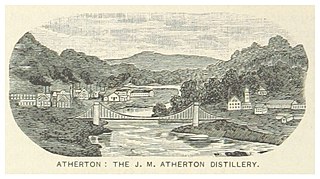
Atherton Whiskey was a pre-prohibition brand of Kentucky Straight Bourbon whiskey first produced by J M Atherton & Co, a chemical and distilling business.





